Brandon Shaw is a Masters student at Kew, studying Plant and Fungal Taxonomy, Diversity and Conservation. Here he guides us through what makes leaves one of the most revealing features of plants.
Why describe a leaf?
Describing is an important part of being a botanist (a scientist who studies plants) because it allows us to have a consistent way of looking at the world around us. It also allows us to communicate with each other without any confusion.
Leaves are important for plants and trees because they photosynthesize to produce energy from light. Nearly all plants have leaves which makes them really important for plant identification.
We often use flowers as the most telling detail when identifying a plant, but not every plant we come across will be flowering, so other parts of the plant must be used for identification. The best part of a plant to use when there are no flowers are the leaves.
Animals with vertebrae (spines) share a basic structure, with parts that have been stretched or shortened to produce a wide variety of different forms – from whale fins, to bat wings, to horse legs and hooves.
In the same way, leaves are also built of the same basic structures that vary from plant to plant. These variations can be used to tell the difference between plant species.
A botanical description is typically a list of measurements and characteristics that can be used to identify a plant. There are many different features that a botanist may choose to include in a description, and a few can be seen in all descriptions. Learn these and you’ll be well on your way to identifying what is growing in your garden!
Opposite or alternate?
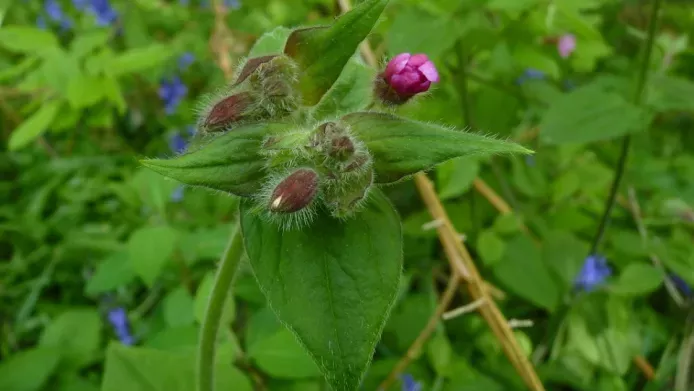
Red campion, Silene dioica
The first step to describing a leaf is to identify the way the leaves are arranged on the stem. Most leaves are either opposite or alternate in arrangement.
Opposite leaves are a pair of leaves growing from the same point, on opposite sides, of the stem.
Alternate leaves only have one leaf growing on the stem each time a leaf occurs. The side of the stem the leaves grow from alternate from one to the other.
You may also come across plants with whorled leaves where three or more leaves are growing from the same point on the stem. Many wildflowers have basal leaves, which is a rosette or cluster at the bottom of the plant.
Red campion (Silene dioica) has opposite leaves and alternate leaves can be seen on common ragwort (Jacobaea vulgaris).
Simple or compound?

Dog rose, Rosa canina
The second characteristic used to describe a leaf is the leaf structure. This can be either simple or compound.
Before identifying whether a leaf is simple or compound it is important to know a few key structures of a leaf:
- Leaf blade – the broad part of the leaf, which is connected to a petiole
- Petiole – the ‘leaf stalk’ that connects the leaf to the stem
- Stipule – a pair of small appendages at the base of the leaf
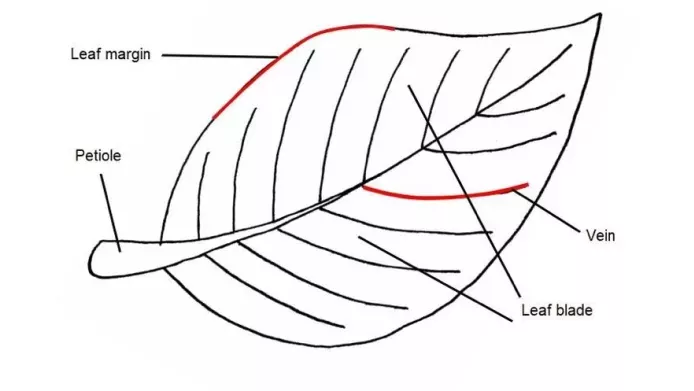
Simple leaves have a single leaf blade where the leaf blade remains connected throughout the whole leaf.
Compound leaves have multiple leaf blades which are not connected, these separate leaf blades are known as leaflets.
Self-heal (Prunella vulgaris) is an example of a plant with simple leaves, and dog rose (Rosa canina) has compound leaves that are divided clearly into multiple leaflets.
However, identifying a simple from a compound leaf is not always so easy. For example, white clover (Trifolium repens) has compound leaves, so if you have ever been lucky enough to find a 'four-leaved clover' what you actually found is a single leaf which has four leaflets (still just as lucky though).
Unlike dog rose leaflets, the leaflets of clover are palmate, which means the leaflets originate from a central point in the same way your fingers originate from the palm of your hand.
The trick to telling a leaflet from a leaf is to identify where the leaf starts. To do this check the base of the leaf or leaflet where it connects to the rest of the plant, if you see any swelling or a stipule, or stipule scar then you are looking at where a leaf starts, if there is nothing and it connects smoothly, you are looking at a leaflet.
Leaf texture
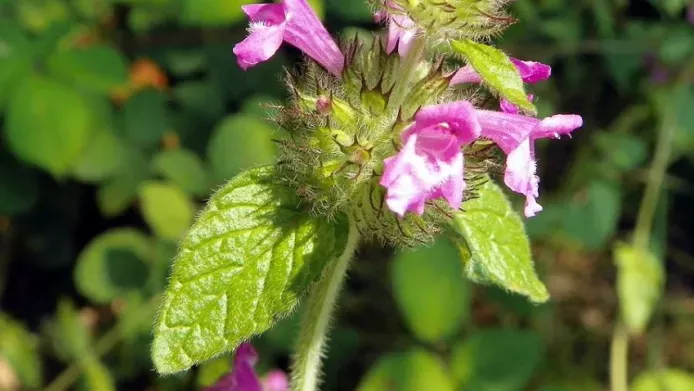
Wild basil, Clinopodium vulgare
Leaves can have a variety of textures. They can be waxy or hairy, papery or silky.
Wild basil (Clinopodium vulgare) has visibly hairy leaves. Some plants have hairier leaves than others so it’s important to be as descriptive as possible to reach an accurate identification faster. Identify how dense the hairs are, whether they are growing in a pattern along the veins, and if they particularly long or short.
Some papery leaves might feel like sandpaper. You should be as detailed and descriptive with a feature like texture as you like, don’t worry about using any specialist language!
The margins of a leaf
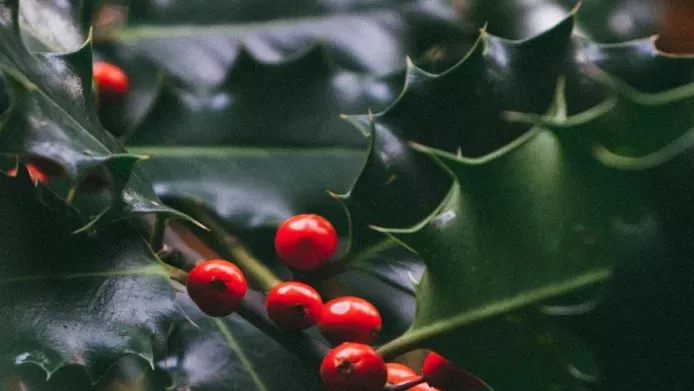
Wild basil, Clinopodium vulgare
The margin, or edge, of a leaf can vary widely. It could be entire (smooth), serrate (toothed like a saw), or spinose (with sharp spines).
Holly (Ilex aquifolium) has waxy leaves with spinose margins whereas white dead-nettle (Lamium album) has hairy leaves with serrate margins.
Leaf veins
Leaves have veins that support the shape of the leaf, as well as transport water and nutrients throughout the leaf.
Leaf veins are useful to identify whether the plant is a monocot or a dicot. Monocots include plants such as grasses (Poaceae) and onions (Allium) and can be identified by the parallel veins running from the base to the end of the leaf.
Dicots, on the other hand, tend to have veins that look more like nets.
If you are struggling to see the veins in a leaf, try holding it up to the light to see if they become clearer.
Putting your new skills into practice
Some plants like to keep botanists on their toes by not having consistent leaves on the entire plant.
Cornflower (Centaurea cyanus) have long stalked basal leaves (the leaves occurring at the base of the plant), but stalkless short leaves on the stem. This is a pattern seen in many wildflowers.
The common poppy (Papaver rhoeas) takes the confusion one step further with lobed leaves where the leaf blade is not a flat sheet – instead it has different rounded or pointed protrusions which have a long central lobe on the upper leaves, with lobes become increasingly smaller and numerous on leaves lower down on the plant.
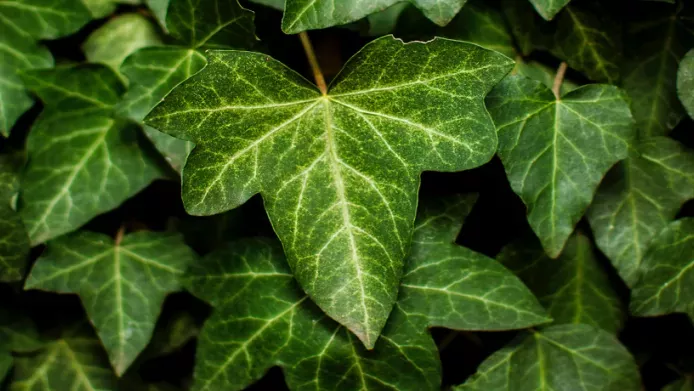
Ivy, Hedera helix
Perhaps the most confusing plant for varying leaves is ivy (Hedera helix), which can look completely different depending on the age of the plant and the time of year. Some leaves may have three to five distinct lobes, whereas the leaves around the flower structure may not be lobed at all and instead be oval or heart shaped.
The lesson all of these plants teach us is to consider the entire plant by looking at examples of leaves from the bottom and the top of the plant.
Now you have seen a few examples of leaf descriptions, why not try and write some of your own? Explore Grow Wild's wildflower identification resources, take a look at our wildflower factsheets and fill out a blank wildflower ID sheet with all of your new leaf knowledge!
To learn more about wildflowers or to put your expertise to the test, have a go at our wildflower quiz.
Follow Brandon on Twitter to find out more about his adventures in botany.
